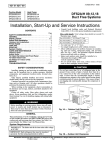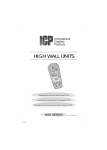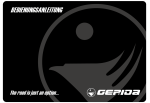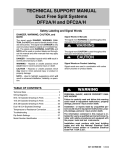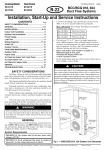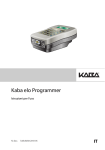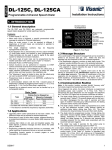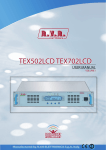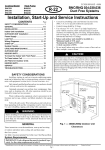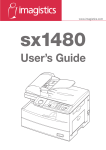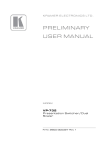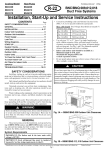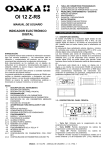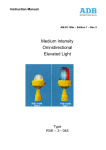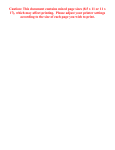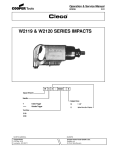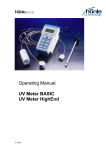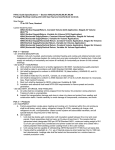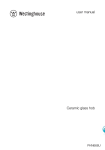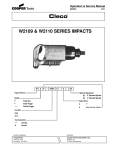Download Installation, Start-Up, and Service Instructions
Transcript
Cooling Model
DFS2A318J2A
DFS2A324J2A
Heat Pump
DFS2H318J2A
DFS2H324J2A
51302618919-B
421 01 9219 00 I
NOV 06
DFS2A/H 2X09, 2X12
Duct Free Systems
Installation, Start-Up, and Service Instructions
CONTENTS
SAFETY
......................
Page
1
GENERAL .....................................
INSTALLATION
..............................
Indoor Unit Installation
........................
Outdoor Unit Installation
........................
1-7
7-14
7
9
SAFETY CONSIDERATIONS
Power Supply ................................
Leak Test .....................................
10
10
Wiring Diagrams ...........................
START-UP ....................................
12-13
14
System Checks ................................
CARE AND MAINTENANCE .......................
Outdoor Units .................................
Indoor Units ...................................
To Clean the Indoor Unit Front Panel ............
To Clean Indoor Coil ...........................
Air Filters for Indoor Units ......................
SERVICE .......................................
TROUBLESHOOTING
........................
14
14
14
14
14
14
14
15
16-19
Installing,
starting
can be hazardous
and equipment
CONSIDERATIONS
up, and servicing
due to system
location
air-conditioning
pressures,
(roofs, elevated
structures,
Only trained, qualified installers
and service
install, start-up,
and service this equipment.
Untrained
personnel
can
perform
basic
working
on the equipment,
components,
etc.).
mechanics
maintenance
such as cleaning coils. All other operations
by trained service personnel.
When
equipment
electrical
should
observe
should
functions
be performed
precautions
in the
literature mid on tags, stickers, mid labels attached to the equipment.
Follow
all safety
codes.
Wear safety
glasses
and work
gloves.
Keep quenching cloth and fire extinguisher
nearby when brazing.
Use care in handling, rigging, and setting bulky equipment.
Safety Labeling and Signal Words
DANGER,
NOTE
WARNING,
CAUTION,
and
Signal
The signal words DANGER, WARNING, CAUTION, and
NOTE are used to identify levels of hazard seriousness. The signal word DANGER is only used on
product labels to signify an immediate hazard. The
signal words WARNING, CAUTION, and NOTE will
be used on product labels and throughout this manual and other manuals that may apply to the product.
Words
in Manuals
The signal word WARNING is used throughout
manual in the following manner:
this
The signal word CAUTION is used throughout this
manual in the following manner:
DANGER - immediate hazards which will result in severe personal injury or death.
WARNING - Hazards or unsafe practices which could
result in severe personal injury or death.
CAUTION - Hazards or unsafe practices which may result in minor personal injury or product or property
damage.
Signal
Words
on Product
Labeling
Signal words are used in combination with colors and/or
pictures on product labels.
NOTE - Used to highlight suggestions which will result in
enhanced installation, reliability, or operation.
GENERAL
ELECTRICAL
SHOCK
Failure to follow
injury or death.
this
These instructions
DFC2A/DFC2H
HAZARD
warning
could
result
in personal
Before installing or servicing system, always turn off main
power to system
and install lockout
tag on disconnect.
There mav be more than one disconnect switch.
cover the installation,
start-up
outdoor
and DFF2A/DFF2H
and servicing of
indoor
units
cooling only and heat pump duct free systems. See Table
parts included. See Tables 2 and 3 for Physical Data.
1 for
SYSTEM
IMPORTANT:
is 30 VDC.
The Indoor
•
units
& the inter units
Each
refrigerant
line
See line sizing requirements
Consult
cable voltage
UNTF COMPONENT
IMPORTANT:
Separately.
REQUIREMENTS
local building
must
be
insulated
in able 2.
codes and National
Electrical
Code
(NEC, U.S.A.) for special installation
requirements.
Max. cable length. Total voltage drop should not exceed
1V. Therefore
•
max. length:
For #18 AWG
24.3 Feet (7.4 m)
For #16 AWG
37.7 Feet (11.5 m)
For #14 AWG
50.0 Feet (18 111)
Failure to follow
components.
DAMAGE
this caution
may result in damage
to unit
Do not bu_ more than 36 in. of refrigerant pipe in the ground.
If any section of pipe is buried, there must be a 6 in. vertical
rise to the valve connections on the outdoor units. If more than
the recommended
the cooler buried
shutdown.
length is buried, refrigerant may migrate to
section duNlg extended periods of system
Use only type "G" or "C" fuses. Use single length power
cable without extension. Allow sufficient space for airflow
clearance on condensing
units for wiring, refrigerant piping,
and servicing unit. See Fig. 1 and 2 for minimum required
distances
•
Indoor
mum
between
length
and veltical
•
unit and walls or ceilings.
and outdoor
units
should
be installed
of 10 ft. apart. Maximum
separation
of 30 ft.
Do not install indoor units near a direct
as direct sunlight,
at a Mini-
line length of 50 ft.
source of heat such
steam or flame.
Fig, 1 -- DFC2A/H318, 324 Outdoor Unit Clearances
Table 1--Parts
ITEM
QTY
Mounting Bracket
List -- High Wall Units
DIAGRAM
2X1
DFF2A/DFF2H
Long Screws
Outdoor
09, 12
2X8
Sensor
2X1
Connecting
Cable
(Available for HEAT PUMP ONLY)
Absorption Cushions
Electric Terminals
2X8
2X
Remote
Controller
Mounting
Bracket
Remote Controller
and Batteries
Insulation
Indoor
Owner's
1 Mounting
Bracket with 2 screws
2X1
for
Fittings
Manual
Wall-mounted
Receiver RTX
2X1
2X1
(OPTIONAL)
(Not Included)
NADA001TW
Table 2--Physical
INDOOR
UNIT
COOLING
CHARGE
MOISTURE
(Btuh)
SEER
TUBE
32 3/32x10
UNIT
NOMINAL
Drop/Max
Length
DIMENSIONS
32 3/32x10
15/64x7
R-22
2 X 19.0
2 X 19.0
9/32
DFC2A324J2A
30/30/50
30/30/50
1/4...1/2
1/4...1/2
(in.)
TYPE
Panasonic-2R13S126A6F
TYPE
Panasonic-2P17SR126B1A
35.5 X 49.5 X 12.6
35.5 X 49.5 X 12.6
226
228
(Ib)
METERING
9/32
(ft)
LxHxW(in.)
NET WEIGHT
15/64x7
R-22
LINE SIZING
Phase...Suction
COMPRESSOR
2 X 4.5
2 X 350 / 2 X 280 / 2 X 220
DFC2A318J2A
CONNECTIONS
Vert Lift/Vert
Mixed
(in.)
TYPE
(Ib)
OUTDOOR
2 X 3.1
2X2.6
2X350/2X280/2X220
LxHxW
NET WEIGHT
2 X 11,400
13.0
2X2.4
(Ib)*
REMOVAL (pt/hr)
REFRIGERANT
2 X DFF2AH12JIA
2 X 9,000
13.0
AIRFLOW
(3 Speeds)
High / Med. / Low Cfm
DIMENSIONS
Only
2 X DFF2AH09JIA
CAPACITY
SYSTEM
Data - Cooling
Piston
(Accurator)
LEGEND
Piston
Accurator
(Accurator)
is non-serviceable
SEER -- Seasonal Energy Efficiency Ratio
*Units are shipped with a factory charge based on 25 ft of refrigerant lines.
Table
INDOOR
3_Physical
UNIT
Data - Heat Pump
2 X DFF2AH09JIA
2 X DFF2AH12JIA
COOLING
SEER
CAPACITY
(Btuh)
2 X 9,000
13.0
2 X 11,400
13.0
HEATING
HSPF
CAPACITY
(Btuh)
17,200
7.7
23,600
7.7
SYSTEM
CHARGE
2 X 2.4
2 X 3.1
2 X 2.6
2 X 4.5
MOISTURE
(Ib)*
REMOVAL (pt/hr)
AIRFLOW
(3 Speeds)
High / Med. / Low Cfm
DIMENSIONS
LxHxW
REFRIGERANT
NET WEIGHT
OUTDOOR
TUBE
2 X 350/2
(in.)
32 3/32x10
TYPE
(Ib)
UNIT
NOMINAL
Mixed
Drop/Max
DIMENSIONS
Length
9/32
WEIGHT
METERING
TYPE
X 220
15/64x7
R-22
2 X 19.0
2 X 19.0
9/32
DFC2A324J2A
30/30/50
30/30/50
1/4...1/2
1/4...1/2
(in.)
Panasonic-2R13S126A6F
LxHxW(in.)
SHIPPING
32 3/32x10
X 280/2
(ft)
TYPE
35.5 X 49.5 X 12.6
226
228
Piston
(Accurator)
Accurator
Seasonal
Performance
Panasonic-2P17SR126B1A
35.5 X 49.5 X 12.6
(Ib)
LEGEND
HPSF -- Heating
15/64x7
2 X 350/2
R-22
LINE SIZING
Phase...Suction
COMPRESSOR
X 220
DFC2A318J2A
CONNECTIONS
Vert Lift/Vert
X 280/2
Piston
is non-serviceable
Factor
SEER -- Seasonal Energy Efficiency Ratio
*Units are shipped with a factory charge based on 25 ft of refrigerant lines,
NOTE: Standard Ambient Operating Limitations - 55 [_F to 125 0F (12.7 [_C to 51.6 [_C).
(Accurator)
ICP
- 3.94
o
o
[I00] MIN.
/
\
/
m
4
rm
[I00]
NOTES:
I. DIMENSIONS IN
2,
_
MINIMUM
INCHES, [ ]
CLEARANCE
FOR
11.81
[300]
SERVICE
AND
MIN.
AIR
z
0
FLOW
[TOP VIEW]
ARE IN MILLIMETERS - DO NOT SCALE.
DIRECTION OF AIR FLOW.
MIN.
E
F
3.0 DIA [76]
A
FOR REFRIGERANT, DRAIN,
POWERAND SIGNAL LINES
3, REFRIGERANT, DRAIN AND POWERCONNECTIONS
MAY BE MADE REAR (LEFT OR RIGHT),
LEFT SIDE, RIGHT SIDE, OR BOTTOM LEFT.
I
INLET
I
[
I
I
I
I
I
I
I
I
I
=
I
AIR
m
F]LTERS
(OPEN COVER FOR ACCESS)
LEFTSIDEVIEW
I RIGHT SIDE VIEW J
IFRONT VIEWI
-EVAPORATOR
COIL
INLET AIR
KNOCKOUT FOR RIGHT SIDE
REFRIGERANT, DRAIN, POWER
SIGNAL LINES
lAND
I_
COOLING
IN
IIIIAIRS_II
"A"
BEAF_NG
%
LINFRARE[
REMOTE OVERRIDE SWITCH
E
DRAIN 0.625 [15.B] - 2B'FLEX BOSE,
MALE BARB CONNECTION (PLASTIC)
NOCKOUT FOR LEFT SIDE
REFRIGERANT, DRAIN, POWER
AND SIGNAL LINES
f
i
SUCTION LINE CONNECTION
"G" MALE FLARE
A
I_L_
I'
_
J rJ
L_OU_O
UNE
CONNECTION 1
"H" MALE FLARE
,/
[BOTTOM VIEW]
KNOCKOUT FOR BOTTOM
REFRIGERANT,DRAIN,POWER
AND SIGNAL LINES
m
ICP
I
UNIT SIZE
DFC2A318J2AI
I
A
B
E
C
I
D
I
E
I
F
I
I
G
I
4_n
DFC2A324J2AI
49_36
Ji
43
I 4.3
I
J2
I
_EJ
_>
o-I
_m
o
o_
ln_ t _gR 796177F
t69
DFC2H324J2A
I 28.6
Z261 7.7_
"
"
,97
1
I
641
,410, 612261 0
m
NOTES:
1 REQUIRED
CLEARANCES,
WITH COIL FACING WALL - ALLOW 6 MINIMUM
1 1 WITH COIL FACING WALL - ALLOW 6 MINIMUM
CLEARANCE
ON COiL SIDE & END
AND 2 FEET MINIMUM
CLEARANCE
ON COMPRESSOR
END FAN SIDE
1 2 WITH FAN FACING WALL - ALLOW 2 MINIMUM
CLEARANCE
ON FAN SIDE AND
6 ON COIL END,
AND 2 FEET MINIMUM
CLEARANCE
ON COMPRESSOR
END COiL SIDE
1 3 ALLOW 2 FEET MINIMUM
CLEARANCE
OVER THE TOP OF UNIT
1 4 WITH MULTI-UNITAPPUCATtON,
ARRANGE
UNITS
SO DISCHARGE
OF ONE DOES NOT ENTER INLET
OTHER
2 DIMENSIONS
iN PARENTHESIS
ARE IN METRIC
3 BRACKET
WITH 1 125 DiA HOLE FOR FIELD POWER SUPPLY
mcm
OF
;0
Zoo
mc
oi ,;
I
I
_
co
m
o
m
co
w
'
FIELD
POWER
CONNECTION
&
i
UNDER
AIR DISCHARGE
Mim
6" [0,15M]
THIS COVER
Min.
2' [0.6M]
CONTROL
TOP VIEW
"P'
-- SEE NOTE 3
CONNECTION
DIA.
VAPOR
LINE
::
MINIMUM
CLEARANCE_
SEE NOTE 1
,,g _,
.25" FLARE
CONNECTION
FLARE
SERVICE
CONNECTION
PORT
SERVICE
PORT
(FROM LIQUID LINE)
/
.25"
FLARE
"R"
DIA.
N_
LINE
_
_1_
t
31
° TYP
"K2"
_.
CONNECTION_
LIQUID
_
_/_t_i
"-_
__
"J2 ....
FLARE
P"
CONNECTION
DIA. VAPOR
FLARE
M"
: ---1
LINE
CONNECTION
"A"
SERVICE
25'
PORT
FLARE
CONNECTION
31
"KI"
SERVICE
PORT
(FROM LIQUID LINE)
.25" FLARE CONNECTION
1
LM
MJ
FRONT
VIEW
"R" DIA. LIQUID LINE
FLARE CONNECTION
=TYP
_
__
.
0.7
[18MM] -VIEW
'_A'_
, rn
<
4. If refrigerant
line route no. 1,2 or 4 are used,
saw blade to carefully remove
covering on the side panel.
5. Run the outdoor
sensor
lines, and drainage
6. Fill the remaining
ant material.
cable,
use a small
the corresponding
electrical
tube through
cable,
plastic
refrigerant
the hole.
wall hole gap with an appropriate
seal-
G
J
J
Fig. 2 --
Indoor
Unit Clearances
Fig. 3 --
INSTALLATION
Plan the installation
carefully
make installation easier.
to avoid
component
failures
Refrigerant
Lines
and
09, 12
Indoor
Unit Installation
REFRIGERANT
LINE ROUTING
-- The refrigerant lines may
be routed in any of the four directions shown in Fig. 3.
INSTALL
THE
MOUNTING
BRACKET
1. Carefully
remove the mounting
bracket,
which is connected to the back of the indoor unit's base with screws.
2. Position
the mounting
ing a spirit
bracket
G-2
ALL DIMENSIONS
ARE IN inches
on the wall and level it us-
level (see Fig. 2 for minimum
required
clear-
09, 12
ance distances).
3. Mark the four drilling
holes
on the wall,
as they appear
in
Fig. 4.
4. Drill the holes,
screws to attach
insert the wall plugs and use four
the mounting bracket to the wall.
5. Check that the bracket
the wall.
DRILL
A HOLE
INTER-UNIT
IN THE
is leveled
WALL
FOR
and securely
long
fastened
DRAINAGE
to
G-2
Fig. 4 --
AND
ALL DIMENSIONS ARE iN mm
Mounting
Bracket
DFF2A/DFF2H
09, 12
CONNECTIONS
To make the connections
between
the indoor
and outdoor
units,
(Optiona_
drill a 2.5-in.
hole through
the wall for the refrigerant
lines,
drainage hose and control cable passage as shown in Fig. 5.
OUTDOOR
for NEAT
SENSOR
\
PBNP
BYSTEfB$}
CABLE
REFRIGERANT
LINES
1. Mark the center of the hole to be drilled according m the refiigerant line routblg used and dimensions shown in Fig. 4.
2. Make
opening
opening
3. Make
hole.
sure to drill
outwards
in the outside
on the inside.
sure the drainage
and downwards,
wall is at least
hose
so that the
1/2" lower
is at the bottom
than the
side of the
_
INDOOR _.tl]
- _
t/2.1N.
MIN
OUTDOOR
- -
_T_lrAI
ELECTRICAL
CABLE
Fig. 5 -- Drill Holes
--
DRAINAGE
TUBE
WIRE
THE
INDOOR
UNIT
1. Strip the cables back 1/4 inch.
2. Remove
pulling
the unit's
it gently
3. Remove
front panel by lifting the lower
outward
and upward.
the two screws
from
part and
See Fig. 6.
the control
box cover
and
take off the cover. See Fig. 7. Save the screws to reassemble.
NOTE:
In general
removal
of the grille frame but in case of need do as follow:
wiring
the indoor
unit
does
not require
4. Remove the two screws from the air discharge
Save the screws to reassemble.
See Fig. 7A.
Pull downwards
and outwards on the bottom of the grille
and gently raise the frame of the top of the unit.
•
Once all covers
are off, mount
•
Remove
Grille
Insert
the unit onto the wall mount-
See Fig. 8.
NOTE:
Leave
covers
Connections
section.
•
Fig. 6 --
the
J
/
opening.
•
ing bracket.
f
j_
•
off
until
after
the
Making
Drainage
Fig. 7 -- Remove Control Cover
Route the interconnecting
unit's
door sensor cable towards
indoor unit.
the lower
electric
cable and the out-
right hand corner
Make sure that the wires are connected
in accordance
of the
with
the wiring diagram on the inside of the unit front cover or
within this instruction manual.
•
Secure the control
•
For heat pump
Fig. 7a -- Remove the screws from the air discharge
opening.
cables to the strain relief.
systems
only, connect
TH3 to its mating black terminal.
the outdoor
sensor
See Fig. 9.
Mount the indoor unit on the mounting bracket
FIRE HAZARD
Failure to follow this warning
could
injury, death and or property damage.
Make
sure that all wires and screws
result
in personal
are firmlv fastened.
REASSEMBLE
1. Connect the display
circuit board.
2. Put the control
the appropriate
Unit section).
connector
to the display
panel printed
_ili;
box cover
screws
and grille
(Steps
frame
back on using
3 and 4 of Wire the Indoor
Put the grille insert back on.
Gently
push
Fig. 8 --
with the arrow
Indoor
Unit
direction
Mounting
Standard
Dip Switches
status from the factory
Model-2
HEAT PUMP
X 12 DIP Switches
(on the control
location
box side)
HEAT PUMP
Model-2 X 09 DIP Switches
location
(on the control box side)
Inter unit
terminal
block
30VDC
Display
COOLING ONLY
Model-2 X 12 DIP Switches location
(on the control box side)
COOLING ONLY
Model-2 X 09 DIP Switches location
(on the control box side)
Fig. 9 -- Outdoor Sensor Connection
TH3
(Heat Pump
Only)
Inter unit cable
clamp
ATTACH
THE
REMOTE
CONTROLLER
MOUNTING
Use only "L" type sealed,
BRACKET
1. Use the two screws supplied with the controller to attach
the mounting bracket to the wall in the location selected
by the customer
2. Install batteries
3. Place remote
et.
4. For remote
Manual.
(see Fig. 10).
in the remote
control
control
dehydrated
copper
refrigerant
tubing.
No other type of tubing may be used. Use of other types
will void the manufacturer's
warranty.
Do not open service valves or remove
protective
tubing ends until all the connections
are made.
of tubing
caps
from
control.
into remote
operation,
control
refer
mounting
to the unit
brack-
Owner's
Bend tubing with special bending tools to avoid the formation of
sharp bends. Take care to avoid kinks or flattening of the tubing.
Keep
the
contaminants
Avoid
tubing
free
of dirt,
to avoid damaging
sags in the suction
sand,
moisture,
the refrigerant
line to prevent
and
other
system.
the formation
of oil
traps.
Insulate
insulation.
each tube
Inserting
with
3/8-in.
walled
thermal
the tubing
into the insulation
pipe
before
making
the connections
will save
time and improve
installation
The suction and mixed-phase
lines should never
come in direct contact.
REMOTE CONTROL
MOUNTING BRACKET
POWER
Fig. 10-
SUPPLY
Attach Mounting Bracket to the Wall
HIGH/LOW
(OPTIONAL)
NADA001TW
TH3
(HEAT
Fig. 11 --Wall
Outdoor
Mounted Unit-
SENSOR
PUMP
METAL
RTX
CONNECTION
Unit Installation
POWER
ONLY)
CONDUIT
PLATE
SUPPLY
CABLE
NOTE:
The
(mounting
outdoor
unit must
be installed
on a solid
surface
UNIT
CABLE
base).
1. Place the rubber absorption
cushions (supplied
with
outdoor unit) under the unit's feet to prevent vibrations.
2. Fasten the outdoor unit legs
shown in Fig. 12. The cushion
the mounting base.
the
to the mounting
base, as
goes between the legs and
3. Be sure that the unit is leveled.
MAKE
REFRIGERANT
DOOR
UNIT) -- To connect
PIPING
CONNECTIONS
the refrigerant
(OUT-
lines:
Make sure to properly identify and separate between the piping
and control cables coming from indoor unit No. 1 and the piping
and cables
INTER
coming
from indoor
unit No. 2
4 ABSORPTION
BE
PUT
UNDER
CUSHION
EACH
TO
LEG
Fig. 12 -- Legs Mounting Base and Wiring Outdoor
Units
Models: DFC2A/H318J2A, DFC2A/H324J2A
INDOOR UNIT 2 X 09, 2 X 12
Operation push button for
automatic operation (23°C/73°F),
turning the a/c OFF, canceling
the malfunction indication,
and resetting the filter LED.
AUTO/OFF
_=) FILTEJ
OFF
ON
,_
T[MEI_
SERVICE
LED
PLASTIC
CONTROL
COVER
IR RECEIVER
FILTER
Fig. 12A -- Indoor unit LED's and Wiring
FLARING
AND CONNECTING
REFRIGERANT
LINES
1. Remove
the protective
cap from the flare fitting.
2. Remove
the protective
cap from
the tubing
3. Disconnect
the vacuum
microns for 5 minutes.
3. Slip the flare nut on the tubing
standard
flaring
and
5. Open the mixed-phase
wrench.
and flare the tube end using
tools.
6. Open the suction
wrench.
4. Tighten the nut until resistance
is met. Mark the nut and
the fitting. Using a suitable wrench tighten an additional V4
turn. Use the following
nection size:
Mixed-Phase
line:
1/4 in.-(12.3
fit-lb.)
Both refrigerant
lated separately
NOTE:
Suction
The
according
7. To evacuate
to con-
TUBING
refrigerant
fit-lb.)
on the outdoor
are connected,
charge nmst be checked
1. Open the service
unit
must
valve (small
line valve
and charge
(large
500
valve
valve)
with an Allen
valve)
with
an Allen
unit No. 2 repeat steps 1 thru 6.
for each additional
3 ft. of tubing
R-22 re0.9 oz. of
length.
THE SYSTEM
air must be expelled,
then
the steps
port cap on the suction
port cap. Using
refrigerant
oil, lubri-
--
and adjusted.
Follow
the service
cate the cap beam and hand tighten until resistance is met.
Use a suitable wrench to tighten the cap by an additional
1/2 turn.
remain
have been made.
AND CHARGE
maintain
9. Make sure that the valves are properly opened. Be careful
not to open them more than required as this may damage
the thread.
10. Replace
valves
should
8. The outdoor
unit is supplied
with sufficient
frigerant for up to 25 ft. lineset length. Add
need to be insu-
service
When all the fittings
refrigerant
below.
torque,
line:
1/2 in.-(36
lines
closed until all 4 connections
EVACUATE
specified
Unit
4. Remove the service port caps from the mixed-phase
and suction line valve
and cut to the
required length. Be sure that the cut is perpendicular
clean, without burrs.
pump.
Power
Supply
13-14
for system wiring
Leak
Test
equipment.
line valve (large
valve of unit No. i).
2. Connect the vacuum pump to the service port of unit No.
1 via the pressure gage and evacuate
to 500 microns to
eliminate contamination
and moisture.
10
--
--
See Tables
Leak
4 and 5 for electrical
data and Fig.
diagrams.
test
all fittings
with
appropriate
test
Table 4_Electrical
UNIT
VOLTAGE
MCA*
Data, Indoor Units -- 30VDC
MOCP*
FULL
LOAD
AMPS
FAN MOTOR
AMPS
COMPRESSOR
AMPS
COMPRESSOR
LOCKED
ROTOR
AMPS
DFF2AH
09JIA
30VDC
N/A
N/A
1.8
1.1
N/A
N/A
DFF2HH
12JIA
30VDC
N/A
N/A
1.8
1.5
N/A
N/A
LEGEND
MCA
MOCP
-
Minimum Circuit Amps
Maximum Overcurrent Protection
* If indoor unit is powered from outdoor terminN block, the MOCP for the
outdoor unit is for both sections
NOTE: Specifications and performance data are subject to change without notice.
3095897
Table
UNIT
5_Electrical
VOLTAGE
MCA*
Data, Outdoor
MOCP*
Units --
FULL
LOAD
AMPS
115, 1-60
FAN MOTOR
AMPS
COMPRESSOR
AMPS
COMPRESSOR
LOCKED
ROTOR
AMPS
DFC2A
318J2A
II5VAC
19.8
25
18
1.00
7.2
42
DFC2H
324J2A
II5VAC
24.6
30
22.2
1.00
9.3
58
LEGEND
MCA
MOCP
*
Minimum Circuit Amps
Maximum Overcurrent Protection
• If indoor unit is powered from outdoor terminal block, the MOCP for the
outdoor unit is for both sections.
NOTE: Specifications
out notice.
and performance
data are subject to change with-
3095897
11
Models2 X 09 / 2 X 12 Wiring Diagram Heatpump
INDOOR
UNIT
®
OUTDOOR
BL.
THlt
tTi2
0
L._
TH3
TH3
RVS
RVS
®
®
TB
J6J7
BLK _
BLK
J8
TB
BLK
J8
TB 1 _
BLK
J18
J1
ILTVI
FAN
-,
-_-_
H.LT.V
-
_RE_O
1._2
i NLW
ii Rv__,
DC RT_
FAN
K5 rTq
H.LT.V
-L_
Lr_LL,,Id
Relay Board
COMP.
-12V
_
BLK
Jll
®
RED *_0VDC
r N
MOTO
j
RED
v
*OR
o
J1
FAN 1 BLUE
F-I
-L,'d
STEF
GREEN
J3
RED+30VDC
BU_OCRTN i
GREEN
FANI BLUE
co(i)
K9
*BLUE
K7
_IFAN
FAN23RgO
BLK
J4
r_
YEL VSP
BLOC
*BLUE
FAN2 REO
--
_,j
MOTOR
TAC
ljl:
K8
!,LL_
K9
i_L_
*BR
670 control
14_-F,J
_
FAN3
B_K
*G_YEL
TAC 671 Main
Board
_J
J_-"
+30v WH
GREEN
_BR
i._2
F-1
12V
BLK*12V
GREEN
J4
.._j ,,
L-J
t
K_
Jt4
PPE
lTo_
J6
___
TAC673
:o_1
12
-
TB
:673
' Boarc
J7
JIB
/_{!_ _
K3
_--_f_ _
-_yEt.
_w__
*BLUE
cc@
COMP
UNITQ
BLK
TH3
®
INDOOR
UNIT
TAO 671 Main
Board
_
TAC672B
s
II OND;
®
TAC 670 control
GND
II
BLK
N BLUE
I I
DC_
LEGEND
LI BR
_GREEN
CC
I1
Capacitor
FC
GND
-Fan Capacitor
*Ground
RVS
*Reversing
115VAC
TH 1
=Return airsensor
TH 2
-Indoor coil sensor
TH3
Main AC Supply
FAN
MOTOR
5130252398i-A
DFF2HH12J1A
-Outdoor
coil sensor
(_
- Indoor unit 1 circuit
(_)
= Indoor unit 2 circuit
FAN
MOTOR
FAN COIL WITH DFC2H318J2A,
DFC2H324J2A
Condensing
""
-16 AWG
_
*
-14 AWG
=12 AWG
ALL OTHER WIRES 18 AWG
Valve Sehoid
HLTV -HeatingLow Tamp.Valve
TB
-Terminal Block
BLDC * brushless DC
LI N_
Fig, 13 -- System Wiring Schematic DFF2HHO9J1A,
-Compressor
COMP*Compressor
Unit
0
•
*
Splice
Terminal(Unmarked)
--
Factory Wiring
......
Field Control
_._
Field Power Wiring
Wiring
Models2 X 09 / 2 X 12 Wiring DiagramCoolingOnly
INDOORUNIT ®
OUTDOOR
BL_
INDOOR
UNIT
L_
-]
®
®
O
TB
J6J7 J8
J1
0
TB 1 J [
BLK
TB1
BLK
FAN
J8
Jl
J7 J6
J18 ___
_BLUE
FAN
LJ
;if
THI
BLK
TB
F-_._
UNITQ
GR_EL
r!
_
BLK
"RE_
OR
"RED
R_I
cc(
_EN
m
K5 r73 l
H,L.'KV
L- _
RVS
_K_._--i'-_K_LL
B.L._V
l._J
TB®
JiB
TB_
! 'B
TAB 673
Relay Board
LJ
BL
KI
TAC 673
:L
KL_L,,.LJ
RMS
L
COMP.
RED+12V
_OR
_
+30V WH
_
+3OV WH
MOTOR
GREEN
K8
i
RE_* 30VDC
FAN 1 BL_
y_L VSp
FAN 2 RED
GREEN
--_,2d
_BR
ccQ
FAN 2 _
BLUE
K7i'-I
BLD_
BLUE
K9
iLLJ
K_i,L;J
MOTOR
'GR/YEL
TAB 671 Main
Board
TAC
GREEN
BR
J._J
_'-_
BLK-12V
GREEN
FAN 1 BLU
-]K8
(9
_BLDC
TAB 674 Main
Board
670 contro{
GND
;
COMP,
®
Q
TAC 678 control
GND
BOE'I:
BLK
BLUE
DC_
LEGEND
L1 BR
_GREEN
CC
-16AWG
-Compressor Capacitor
rk4 AWG
-42 AWG
BOMP-Compressor
FC@
L1N_
FC
-Fan Capacitor
GRD -Ground
_L OTHER WIRES 48 AWG
TB
-Terminal Block
BLDB * brushless DB
0
•
TR t
-Return airsensor
--
Factory Wiring
TH 2
-Indoor coil sensor
......
Field Control Widng
_._
Field Power Wiring
115VAC
-Indoorunitl
_)
*
*
circuit
- Indoor unit 2 circuit
Main ACSupply
FAN
MOTOR
51302523982-A
Fig. 14 -- System Wiring
Schematic
DFF2AHO9JIA,
DFF2AH12JIA
FAN
MOTOR
FAN COIL WITH DFC2H318J2A,
DFC2A324J2A
Condensing
Unit
Splice
Terminal(Unmarked)
START-UP
System
dirt and debris
Checks
Indoor
1. Conceal
3. Ensure
all tubing
4. Fasten tubes
6. Connect
tube slopes
and connections
downward
are properly insulated.
of unit. Fan mo-
Units
ELECTRICAL
which
the cables and tubing
the air conditioner
to the power
all air conditioner
operating
er's Manual for operating
pass.
Refer to Own-
remote
located
details.
UNIT
1. Do all the remote
2. Do the display
controller
buttons
function
HAZARD
this
warning
could
result
in personal
To avoid the possibility of electric shock, before performing
any cleaning and maintenance
operations,
always turn off
power to the system by pressing the ON/OFF button on the
source and turn it
modes.
SHOCK
Failure to follow
injury or death.
Oil.
control and turn off the separate
near the unit.
If the indoor unit is on a separate
disconnect off as well.
properly?
disconnect
switch
switch, be sure to turn this
panel lights work properly?
3. Does the air deflection
4. Does the drainage
OUTDOOR
in base
along
to the outside wall.
5. Seal the hole through
INDOOR
holes
the tubing where possible.
2. Make sure that the drainage
its entire length.
7. Check
from drain
tors are waterproof.
louver
function
properly?
work?
COMPONENT
UNIT
1. Are there unusual
Failure
noises or vibrations
2. Is noise, drain water or airflow
turb the neighbors?
during
operation?
from the unit likely
DAMAGE
HAZARD
to follow this may result in unit component
damage.
Do not wash
filter
in water
over
120°F
(to avoid
shrinkage).
Do not expose
filter to fire (to avoid fire
damage). Do not expose filter to direct sunlight. Clean filter
more frequently when air is extremel'¢ dirty.
to dis-
3. Are there any gas leaks?
EXPLAIN THE FOLLOWING
ITEMS TO THE CUSTOMER,
WITH THE AID OF THE OWNER'S
MANUAL:
1. How to turn the air conditioner
on and off; selecting
cool-
ELECTRICAL
HAZARD
ing, heating and other operating
modes: setting a desired
temperature:
setting the timer to automatically
start and
stop air conditioner
operation: and the other features of the
remote
controller
2. How to remove
and display
Do not attempt
box.
louver.
Manual
To Clean
Outdoor
may be performed
result
in personal
and installation
instructions
carefully
by the equipment
to clean
the Indoor
or service
Unit Front
components
Panel
--
in control
if the front panel of
the unit becomes dirty or smudged, wipe the out-side of the panel
with a soft dry cloth. Use a mild liquid deter-gent
and wipe off
CARE AND MAINTENANCE
The following
DAMAGE
panel.
4. Explain care and maintenance.
5. Present the Owner's
to the customer.
FIRE COMPONENT
Failure to follow this warning
could
injury, death and or property damage.
and clean the air filter.
3. How to set the air deflection
SHOCK,
To Clean
with a dry cloth.
Indoor
Coil --
front panel and vacuum
damage fins.
owner.
To clean the coil, remove
the coil fins, using
indoor
unit
care not to bend
or
Units
LUBRICATION
-outdoor-fan
motors
Air Filters
The indoor-fan,
automatic air sweep, and the
are factory lubricated and require no oiling.
for Indoor
Units
ELECTRICAL SHOCK HAZARD
Failure to follow this warning could result in personal
injury or death.
Before performing recommended maintenance, be sure unit
main pow*er switch is turned off.
CLEANING
COILS -- Coil should be washed out with
COMPONENT
water or blown out with compressed
air. Clean coil annually or as required by location and outdoor air conditions. Inspect coil monthly and clean as required. Fins
are not continuous through coil sections. Dirt and debris
may pass through first section, become trapped between
the row of fins and restrict outdoor unit airflow. Use a
Operating your system with dirty air filters may damage the
indoor
unit
and,
in
addition,
can
cause
reduced
flashlight to determine if dirt or debris has collected
tween coil sections. Clean coil as follows:
DAMAGE
Failure to follow
damage.
HAZARD
this caution
may result
in unit component
performance,
intermittent
system operation,
frost build up
on the indoor coil, and blown fuses. Inspect and clean or
replace the air filters monthly.
TO REMOVE
AIR FILTERS
--
lifting the lower part and pulling
Pull out the filters.
be-
TO CLEAN
1. Turn off unit power and install lockout tag.
vacuumed
2. Using a garden hose or other suitable equipment, flush
coil from the outside to remove dirt. Be sure to flush all
excess water,
14
OR
or washed
REPLACE
in warm
and replace
Open
the unit's
it gently
FILTERS
water.
it back.
front
outward
--
panel by
and upward.
Filters
can
be
Shake filter to remox, e any
If the filter has begun
to break
downor istorn,replace
it. Replacement
filtersareavailable
through
alocaldealer.
Clean
cleaned
SERVICE
The following
technician.
should
be performed
or Replace
or replaced
Drain
Pan --
by a qualified
The drain pan should
service
1. Place a plastic sheet on the floor
may spill from the drain pan.
by a qualified
service
Clean Condensate
Drains -- (;lean all drains and drain pans at
the start of each cooling season. Check the flow by pouring water
into the drain.
15
to catch
2. Remove
the intake grille and distribution
3. Remove
the condensate
water drain into a 3-gallon
water
only be
technician.
any water
that
assembly.
in the drain pan by letting
bucket.
TROUBLESHOOTING
ELECTRICAL
SHOCK
Failure to follow
injury or death.
this
(Tables 6-8, and Fig. 15)
HAZARD
warning
Be sure to check for broken
troubleshooting
system.
could
STATUS
Indicators
INDICATION
CORRECTION
Check
1 Flash
Faulty
TH1
Sensor
the THI
thermistor
Check for proper
Replace
Faulty
TH2
Sensor
Low Pressure
Check system
High Pressul_e
Check operating
Low Voltage
6 Flashes
High Voltage
Check electrical
Check operating
Check electrical
if necessary.
charges.
(THI and TH2) for correct resistance.
pressures.
Check refrigerant
Check thermistors
5 Flashes
charges.
(THI and TH2) for correct resistance.
voltage.
connections.
voltage.
connections.
OPERATION
LED.
INDICATES ERROR
POWER LED.
OFF WHEN SYSTEM IS
OPERATING AND FLASHES
WHEN SYSTEM IS IN ERROR
(DOES NOT INDICATE ERROR CODE)
CLEAN FILTER INDICATOR
FLASHED AFTER 250 HOURS
OF OPERATION
Fig. 15 -- Indicator Lights
16
resistance.
pressures.
Check refrigerant
Check thermistors
4 Flashes
for correct
connection.
thermistor
Check system
3 Flashes
resistance.
if necessary.
thermistor
Check for proper
Replace
for correct
ACTION
connection.
thermistor
Check the TH2
2 Flashes
in personal
wires or loose cable lugs before
Table 6_Service
LAMP
result
Table 7--DFS2A/DFS2H
Thermistor TH-1, TH-2, and TH-3 Temperature to Resistance Conversion
TEMPERATURE
TEMPERATURE
(_C)
TEMPERATURE
TOLERANCE
(_P)
TEMPERATURE
TOLERANCE
(_C)
-4.0
-20
±2.0
±1.1
30.89
32.44
34.05
-2.2
-19
+2.0
+1,1
29.46
30.93
32.45
-0.4
-19
+ 2.0
+ 1.1
28.12
29.51
30.94
1,4
-17
± 2.0
± 1.1
26.84
28.16
29.51
3.2
-16
± 2.0
± 1.1
25.64
26.88
28.15
5,0
-15
+2.0
+1,1
24.49
25.66
26.87
6,8
-14
+2.0
+1,1
23.40
24.52
25.66
8,6
-13
±2.0
±1.1
22.38
23.43
24.50
19.4
-12
±2.0
±1.1
21.40
22.39
23.41
12.2
-11
+2.0
+1,1
20.47
21.41
22.38
14.0
-10
+ 1.8
+ 1.0
19.59
20.48
21.40
15.8
-9
±1.8
±1.0
18.74
19.59
20.45
17,6
-8
±1.8
±1.0
17.94
18.74
19.56
19.4
-7
+1.8
+1,0
17117
17193
18171
21.2
-6
+1.8
+1.0
16.44
17.16
17.90
23.0
-5
--+1.8
--+1.0
15.75
16.43
17.13
24.8
-4
±1.8
±1.0
15.10
15.74
16.40
26,6
-3
+1.8
+1.0
14.47
15.08
15.71
28.4
-2
+ 1.8
+ 1.0
13.87
14.46
15.05
39.2
-1
±1.8
±1.0
13.31
13.86
14.42
32.0
O
--+1.8
--+1.0
12.77
13.29
13.83
33.8
1
+1.8
+1.0
12.25
12.74
13.25
35.6
2
+1.8
+1.0
11.75
12.22
12.70
37.4
3
--+1.8
--+1.0
11.28
11.73
12.18
39,2
4
±1.8
±1.0
10.83
11.25
11.68
41.0
5
+1.8
+1.0
10.40
10.80
11.21
42.8
6
+1,8
+1.0
9.986
10.370
10.76
44.6
7
+1.8
+1.0
9.595
9.960
10.33
46.4
8
+1.8
+1.0
9.222
9.569
9.921
48.2
9
±1.8
±1.0
8.866
9.196
9.530
59.0
10
±1.8
±1.0
8.526
8.840
9.157
51.8
11
+1.8
+1.0
8.197
8.496
8.797
53.6
12
+1.8
+1.0
7.883
8.167
8.453
55.4
13
±1.8
±0.6
7.583
7.853
8.125
57.2
14
--+1.8
--+0.6
7.296
7.553
7.812
59.0
15
+1.8
+0.6
7.022
7.267
7.513
69.8
16
+1.6
+0.9
6.761
6.993
7.227
62.6
17
±1.6
--+0.9
6.510
6.731
6.954
64.4
18
±1.6
±0.9
6.271
6.481
6.693
66,2
19
+1.6
+0.9
6.042
6.242
6.444
68.0
20
+1.8
+o.6
5.822
6.013
6.205
69.8
21
±1.6
±0.9
5.611
5.793
5.975
71.6
22
±1.6
±0.9
5.408
5.581
5.755
73.4
23
+1.8
+0.6
5.214
5.379
5.544
75.2
24
+1.6
+0.9
5.028
5.185
5.343
77.0
25
_+1.8
±0.9
4.850
5.000
5.150
78.8
26
±1,6
±0.9
4.675
4.821
4.968
89.6
27
+1.6
+o.e
4.508
4.650
4.793
82.4
28
+1.8
+0.9
4.347
4.486
4.626
84.2
29
±1,8
±1.0
4.193
4.329
4.466
86.0
30
± 1.8
± 1.0
4.046
4.179
4.312
87.8
31
+1.8
+1.0
3.904
4.033
4.163
89,6
32
+1,8
+1.0
3.767
3.894
4.020
91,4
33
±1,8
±1.0
3.637
3.760
3.884
93.2
34
±1.8
±1.o
3.511
3.631
3.752
NOTE: Resistance tolerance
_+ 3%.
17
MINIMUM
RESISTANCE
(K_)
MEAN
RESISTANCE
(K_)
MAXIMUM
RESISTANCE
(K_)
Table 7 --DFS2A/DFS2H
Thermistor TH-1, TH-2, and TH-3 Temperature to Resistance Conversion (Cont.)
TEMPERATURE
_F)
TEMPERATURE
(L_C)
TEMPERATURE
TOLERANCE
_F)
TEMPERATURE
TOLERANCE
(_C)
MINIMUM
RESISTANCE
(K_)
MEAN
RESISTANCE
(K_)
MAXIMUM
RESISTANCE
(K_)
95.0
35
+ 1.8
+ 1.0
3.391
3.508
3.626
96,8
36
+ 2.0
+ 1.1
3.275
3.390
3.505
98.6
37
± 2.0
± 1.1
3.164
3.276
3.389
100.4
38
±2.0
±1,1
3.058
3.167
3.277
102.2
39
+2.0
+1,1
2.956
3.062
3.169
104.0
40
±2.0
±1.1
2.857
2.961
3.066
105.8
41
+2.6
+1.1
2.762
2.864
2.966
107.6
42
±2.0
±1.1
2.671
2.770
2.870
109.4
43
+2.2
+1.2
2.583
2.679
2.777
111.2
44
±2.2
±1,2
2.498
2.593
2.688
113.0
45
+ 2.2
+ 1.2
2.417
2.509
2.602
114.8
46
±2.2
±1.2
2.339
2.429
2.520
116,6
47
+2.2
+1.2
2.264
2.352
2.441
118,4
48
±2.3
--+1.3
2.192
2.227
2.364
120.2
49
+2.3
+1.3
2.122
2.206
2.291
122.0
50
±2.3
±1.3
2.055
2.137
2.220
123.8
51
+2.3
+1.3
1.990
2.070
2.151
125.6
52
±2.3
±1.3
1.928
2.006
2.085
127.4
53
+2.3
+1.3
1.867
1.943
2.021
129.2
54
±2.3
±1.3
1.809
1.883
1.959
191.0
55
+2.5
+1.4
1.753
1.826
1.900
192.8
56
±2.5
±1.4
1.699
1.770
1.842
194.6
57
+ 2.5
+ 1.4
1.647
1.717
1.787
196.4
56
±2.5
±1.4
1.597
1.665
1.734
198.2
59
+ 2.5
+ 1.4
1.549
1.615
1.683
140.0
6O
--+2.5
--+1.4
1.503
1.567
1.633
141.8
61
±2.7
±1.5
1.458
1.521
1.585
143.6
62
+ 2.7
+ 1.5
1.414
1.476
1.539
145.4
63
± 2.7
± 1.5
1.372
1.432
1.494
147.2
64
+2.7
+1.5
1.332
1.391
1.451
149.0
65
±2.7
±1.5
1.293
1.350
1.409
150.8
66
+ 2.9
+ 1.6
1.255
1.311
1.369
152.6
67
± 2.9
± 1.8
1.219
1.274
1.330
154.4
68
+2.9
+1.6
1.184
1.237
1.292
156.2
69
±2.9
±1.6
1.150
1.202
1.256
158.0
76
+2.9
+1.6
1.117
1.168
1.221
NOTE: Resistance tolerance
_+ 3%.
18
Table
SYMPTOM
Unit Fails to Start.
8---General
PROBABLE
System
Troubleshooting
Guide
CAUSE
CORRECTIVE
Power supply from outdoor unit to indoor unit is
not connected.
Power supply to unit not connected
LED Off).
ACTION
Check for proper connection of power at disconnect.
(POWER
Fuse blown (POWER LED Off).
Reset circuit breaker or replace line fuse.
ON/SEND button has not been pressed.
Press ON/SEND button on remote control.
Indoor unit does not receive transmitted commands,
Make sure that nothing is blocking the remote control transmission to the unit.
Only Indoor Fan Works
when Cooling or Heating is Desired. NOTE:
Indoor fan runs continuously in cooling mode.
The selected mode is Fan Only, or Cool when
heating is desired,
Check if the remote control is in the desired mode. If not, select
the correct mode (refer to User manual). Also note that every 15
minutes (maximum) the compressor will be switched minimally
on for 3 minutes.
Temperature is set to a value which is too high (in
Cool mode),
Observe the temperature setting on the remote control. Also note
that each 15 minutes (maximum), the compressor will be
switched on minimally for 3 minutes.
Only Indoor Fan Motor
and Outdoor Fan Motor
are Working. No Cooling and/or Heating
Overload safety device on compressor is cut out
due to high temperature.
Switch off power and try again after one hour.
Compressor run capacitor is burnt.
Replace compressor run capacitor.
Takes Place.
Compressor winding shorted.
Replace compressor.
No Air Supply at Indoor
Unit (Compressor Operates),
Indoor fan motor is blocked or turns slowly.
1. Check vottage. Repair wiring if necessary.
2. Check indoor fan wheel if tight on motor shaft. Tighten if necessary.
Indoor fan motor capacitor is burnt.
Replace indoor fan motor capacitor.
Indoor fan motor winding is burnt.
Replace indoor fan motor.
In Heat mode: Delayed start for indoor fan motor.
Normal software delay (maximum of 20 sec).
Clogged air filters.
Clean filters.
Lack of refrigerant. Ice formation on the evaporator coil.
Unit must be charged (according to the nameplate) after Iocalizing the gas leak.
Clogged air filters.
Clean filters.
In Heat Mode, Only
Compressor Runs. Outdoor and Indoor Fan
Motors are Stopped.
A/C operating in defrost cycle.
Wait 10 minutes (maximum) until the unit resumes normal operation.
Water Accumulates
and Overflows from
Evaporator Drain Pan.
Drain pan pipe or hose is clogged or the spout of
drain pan is clogged,
Disassemble plastic drain pipe from spout of evaporator drain
pan. Flush with clean water.
Unit Does Not Operate
in Desired Mode.
The unit is in the Auto, (emergency) mode.
Push button once to cancel Auto, (emergency) mode.
Faulty remote control settings.
1. If remote control symbols respond to the commands correctly,
check the unit ID Code (Standard or Alternative). Refer to
"Changing Unit ID Code" in the Owner's Manual.
Low Capacity.
2. If Oool commands are OK, but Heat symbol is skipped on
LCD, refer to setting the remote to cooling or heat pump on the
Owner's Manual.
3. Replace remote control.
The Unit Receives Interference from Other Remote Control or the Remote Control Interferes
with Other Instruments.
Remote control low battery.
Replace remote control batteries.
Common Infrared Code.
Modify the Remote Control IR transmission code.
Refer to "Changing Unit ID Code" in the Owner's Manual.
IMPORTANT:
The units
are designed
to work
in heat mode
only down
to -10°C
(14 ° F) outdoor
If at starting time outdoor temperature
is equal or lower than -10°C
(5) times to indicate that low temperature
protection
is activated.
(!4°F)
ambient
temperature.
the unit wil! not start and the filter led will flash
International Comfort Products, LLC
Lewisbur_, Tennessee 37091
Manutacturer
reserves
the right to discontinue,
or change
at any t_me, speolhCatlOnS
19
or designs
without
notice
and without
incurring
ObllgBtlons,
five



















